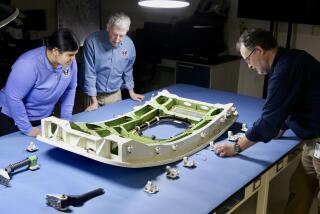Government Moving Quickly to Find More Secure Cockpit Doors
- Share via
WASHINGTON — Replacing flimsy airline cockpit doors with sturdier models capable of thwarting hijackers has emerged as a top priority of an emergency advisory panel to Transportation Secretary Norman Y. Mineta, according to government and industry officials.
The Federal Aviation Administration has begun soliciting plans for a “secure cockpit” from engineering design firms. Boeing, the world’s largest airplane manufacturer, has assigned its engineers to study the issue.
But unless the FAA is ready to mandate sturdier doors, door frames, hinges and locks, the industry might balk at the cost, which one executive estimated at $50,000 per aircraft.
Hardened cockpit doors are about the only physical change to jetliners now under discussion that might deter the sort of hijacks that culminated in the Sept. 11 attacks on the World Trade Center and the Pentagon. Otherwise, attention is focused on procedural changes such as passenger screening and baggage checks.
In the past, security improvements have languished after the initial shock of an attack faded. After the 1988 bombing of Pan Am Flight 103, for example, the FAA approved bomb-resistant cargo containers. But since the agency did not require the use of the super-strong containers, only a few international carriers obtained them, among them Israel’s El Al.
“The underbelly of the airplane was never fully fixed,” said William M. Baker, former assistant FBI director in charge of criminal investigations at the time of the Pan Am 103 disaster over Lockerbie, Scotland.
This time, however, Mineta and his aides have all but promised action. And the powerful Air Line Pilots Assn. last week dropped its opposition to stronger door locks.
“Unauthorized cockpit access is our primary concern,” ALPA spokesman John Mazor said Tuesday. “Our first priority is getting stronger, more secure designs approved and in place.”
In the past, ALPA had argued that strong locks could hamper pilots’ quick escape in a crash and turn the cockpit into a coffin.
Until the FAA approves a completely redesigned door, Mazor said, the union was endorsing the temporary use of deadbolt locks that cannot be opened from the outside. It is unclear whether the airlines will install such locks because Mineta has promised a decision on permanent changes in a matter of weeks.
Along with new doors would come more restrictive procedures for the crew. Access to the cockpit by flight attendants would be limited and pilots would not be able to walk into the passenger cabin at will.
Physically reinforcing the cockpit is not as simple as it may sound, aviation experts said. For example, in the event of a rapid decompression of the cabin or cockpit, a completely sealed door could become dislodged and sucked through the plane like a missile, risking incapacitating injury or catastrophic damage to the aircraft.
But some experts said the materials and technology are readily available to create a secure cockpit that would also satisfy safety concerns.
New Jersey-based Galaxy Scientific Corp. said it has designed such a door, and is supplying the specifications to the FAA. Company President Jimmy Yoh called today’s door “a piece of cardboard” that “is no particular obstacle to a hijacker.”
Yoh said his firm’s doors and door frames use a lightweight but bulletproof material made partly of aluminum and produced by Alcoa. The locks and hinges are similar to those used in bomb-resistant cargo containers, which also are built by Galaxy Scientific. A vent system allows the air pressure in the cockpit and cabin to equalize.
Boeing spokesman Tim Neal said his company also is focusing on ideas for improved cockpit security, not only in new aircraft but in the 13,687 it already has in service. “But we think it is premature to discuss any changes,” Neal said, “and I don’t think there will be a whole lot of public information, for obvious reasons.”
Michael Mayer, general manager of El Al airlines in New York, said the Israeli carrier already has a reinforced cockpit. Industry sources said El Al relied on Kevlar, a material commonly used in bulletproof vests.
“We have invested a lot of effort over the years” on security, Mayer said. “We are well aware of the hazards and the risks.”
Mineta’s advisory panel on airliner security, which is supposed to report to him by Oct. 1, includes American Airlines Vice Chairman Robert W. Baker; Robert A. Davis, a recently retired Boeing vice president for engineering; Patricia Friend, international president of the Assn. of Flight Attendants; and Duane Woerth, president of the Air Line Pilots Assn.
Staff writer Ronald J. Ostrow contributed to this story.
More to Read
Inside the business of entertainment
The Wide Shot brings you news, analysis and insights on everything from streaming wars to production — and what it all means for the future.
You may occasionally receive promotional content from the Los Angeles Times.










